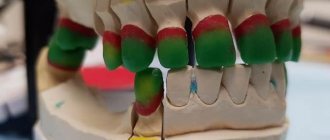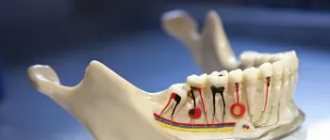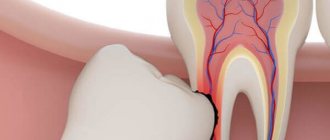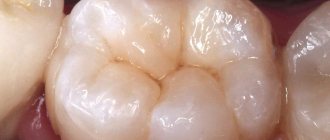Molars are divided into canines, incisors, premolars, and molars. The first three types of teeth erupt in place of similar milk teeth. In turn, molars do not have predecessors and appear behind the temporary ones, therefore their second name is accessory.
Each jaw has 16 teeth - four incisors, two canines, four premolars and six molars. In some cases, third molars, better known as wisdom teeth, do not erupt because they do not have buds in the jaw - then instead of 16, a person has 14 teeth above and below. Experts explain this phenomenon by a reduction, or simplification, of the dental system caused by changes in dietary style.
Anatomical features of the upper teeth
- The central incisor (the largest of all eight) has a chisel-shaped crown with a convex surface and one cone-shaped root. The only root canal in 75% of cases is straight.
- The lateral incisor with the same chisel-shaped crown and the same convex surface has a characteristic depression in the enamel - a “blind fossa”. There is one root canal, but more often it is deviated to the side.
- The canines on the upper dentition are often larger than those on the bottom. They are characterized by a crown pointed on all sides and the longest cone-shaped root. Canines have a single root canal, which can be straight (45%), distally deviated (30%) or vestibular deviated (12%).
- The first premolar with a prism-like crown is characterized by a convex lingual surface. On the chewing side there are tubercles, and between them there is a fissure. In the upper dentition, these teeth are always larger than in the lower one. The root has extended longitudinal grooves, which divide it in 60% of cases into two parts - buccal and palatal. There are often also two root canals.
- The second premolar with the same prism-shaped crown has predominantly one straight cone-shaped root with expanded lateral surfaces. Sometimes the root bifurcates closer to the top. There are often two root canals.
- The first molar is the largest tooth in the dentition. The rectangular crown has a diamond-shaped chewing surface with four cusps and an H-shaped fissure between them. There are usually three root canals, but sometimes there are 4 (25%) or 5 (1%).
- The second molar with a classic cube-shaped crown has 4 cusps and an X-like fissure on the chewing side. The tooth has 3 roots and three (87%) or four (13%) canals.
Diagnosis and treatment of maxillary second molars with two palatal roots
In addition to ideal knowledge of the morphology of the root system, every doctor during endodontic treatment must also know the prevalence of individual aberrations deviating from normal anatomy in order to identify all changes and features of the root structure before treatment begins.
In clinical practice, conventional radiography and an operating microscope are, in principle, sufficient for an objective assessment of the anatomy of the root canal, but it is quite difficult to achieve any more rigorous detail using these methods. It is for this purpose that endodontics uses cone beam computed tomography (CBCT), which is simply a critically necessary diagnostic tool that allows for a comprehensive assessment of all the features of root morphology (most often the molars of the upper jaw need this). One of the most unusual and rare forms of anatomical aberration appears to be the case of a maxillary second molar with two separated palatal roots. This article presents a clinical case of treatment of a patient with the above-mentioned features of the root system. Clinical case A
26-year-old patient sought help at the Department of Therapeutic Dentistry and Endodontics of the University of Belgrade with the following symptoms, which had bothered him for several weeks:
- spontaneous attacks of pain in the area of the left maxillary molar;
- moderate sensation of pain when eating solid food.
From the anamnesis it was also possible to find out that:
- no other symptoms were observed, there was no irradiation of pain;
- this tooth underwent endodontic treatment several years ago;
- two teeth on the offending side of the upper jaw were removed at least ten years ago.
During the clinical study it was possible to establish that:
- on the left side of the upper jaw there was only a second molar (tooth 27) with a huge amalgam restoration;
- the patient showed moderate sensitivity to vertical percussion of the buccal tubercle and a painful reaction to percussion of the mesiopalatal tubercle;
- no sensitivity to palpation of the vestibular or palatal sides was detected near the disturbing tooth;
- tests for hot and cold stimuli, as well as electroodontometry showed negative results;
- No signs of pathological tooth mobility were found.
A diagnostic periapical radiograph revealed:
- partially obturated palatal and mesiobuccal root canals and unobturated distal buccal root canal;
- an area of slight radiolucency around the apex of the palatine root; lack of a distinctive border with the surrounding bony structure of the maxillary sinus.
The need for repeated endodontic treatment was explained to the patient, to which he immediately agreed, after which a plan for subsequent visits was drawn up.
Treatment procedure
The old amalgam restoration and phosphate cement liner were completely removed and the cavity walls were further prepared to provide clear visibility and straightforward access to all root canal orifices. The openings of the palatal and mesiobuccal root canals were obturated with phosphate-iodine cement material and gutta-percha pins. Approximately 3 mm distal to the orifice of the obturated palatal root canal, an oval foramen with perforation was found. Further assessment of the pulp chamber was carried out using magnifying loupes (4.5X) and an Endodontic Probe Orifice Opener (DENTSPLY Maillefer). Using a probe and a size 10 K-file, a second palatal canal (distal palatal canal) was identified in the area of the foramen ovale. The orifice of the distobuccal root canal was hidden under brown deposits of tertiary dentin and was located approximately 2 mm distal to the obturated orifice of the mesiobuccal canal and approximately 2 mm more buccal to the orifice of the distalopalatine canal. The orifice of the distobuccal canal was slightly widened with an instrument to make it easy to identify later. The second mesiobuccal root canal was not found even under the control of loupes after applying a decalcifying solution (17% EDTA).
After consultations and obtaining the patient’s consent, it was decided to carry out the entire procedure in two stages. First, using rotating nickel-titanium files, ProTapers D1, D2 and D3 (DENTSPLY Maillefer) and manual H-files (DENTSPLY Maillefer), root fillings were removed from the mesiobuccal and mesiopalatal root canals. Further instrumental processing of these canals was carried out with reciprocating movements using WaveOne files (DENTSPLY Maillefer): the mesiopalatal canal with a tool with black markings (# 40), the mesiobuccal canal with a red marking (# 25). The working length was determined and checked several times during the treatment using an electronic apex locator (RomiApex A-15, Romidan).
The distal palatal root canal was completed to approximately 1–1.5 mm from the apical foramen using size 10 and 15 K-files. The coronal part of the canal was expanded using Gates–Glidden burs sizes 3 and 2. The same procedure was performed in the distobuccal root canal. Thus, it was possible to achieve direct access and visibility of all four channels (photo 1).
Photo 1. Straight-line access to all four canals of the 27th tooth.
X-rays were taken at two different horizontal angles with K-files in all four canals, but only one image was able to differentiate all four of them (photo 2) with vague contours of the apical parts of the roots. The mesiobuccal canal was filled with calcium hydroxide, and a paper point soaked in 2% chlorhexidine solution (R4, Septodont) was left in the mesiobuccal root canal. A cotton swab soaked in chlorhexidine was left in the pulp chamber, and the cavity was closed with a temporary filling material. After two weeks, the distal-palatal and distal-buccal root canals were carefully prepared using the same WaveOne technique as for the MP and MB root canals: the distal-palatal canal with a black-marked instrument (#40) and the distal-buccal with a red (#25). The working length was determined and checked in the same way.
Throughout the endodontic treatment, solutions of 2.2% sodium hypochlorite and 10% citric acid were used as irrigants in all four canals. Each of the four canals was finally irrigated with 40 ml of 2.2% NaOCl, dried and obturated with Acroseal (Septodont) with one gutta-percha point of appropriate taper (DENTSPLY Maillefer; Figure 3).
Photo 2. Identification of all four canals of tooth 27 on a targeted radiograph.
Photo 3. Obturated orifices of the root canals of the 27th tooth.
The results of post-treatment intraoral retro-alveolar radiography were of relatively poor quality due to overlap and interference of the lower zygomatic arch and adjacent bony structures, making it extremely difficult to objectively assess the condition of the periapical tissues (Figure 4). With the patient's consent, a CBCT scan was performed, which made it possible not only to verify the result of the treatment, but also to document an extremely rare clinical case. With the formation of a small field of view (50 x 50 mm) and using the SCANORA 3Dx device (Soredex), treatment results were recorded immediately after treatment and at a six-month follow-up period. The edited images (OnDemand3D, Cybermed) clearly visualized the two separate palatal roots, as well as their position in relation to the two buccal roots and adjacent anatomical structures, but most importantly, it was possible to objectively assess the quality of obturation of all four root canals (photos 5-9).
Photo 4. Intraoral radiography of the 27th tooth did not provide objective information regarding the quality of treatment.
Photo 5. Axial cut at the mid-length of the roots.
Photo 6. Axial section in the apical region.
Photo 7. Sagittal section of the 27th tooth.
Photo 8. Detailed view of tooth 27 after treatment
Photo 9. Volumetric rendering and multiplanar reformats of tooth 27 after treatment.
Conclusions and Key Points
Careful evaluation of the internal anatomy of the pulp chamber is critical to identifying all root canals. An upper second molar with two separate palatal roots is a rare anatomical aberration, and to our knowledge such a clinical case is encountered only once every ten years. CBCT images provide more accurate and reliable information about roots and root system morphology compared to conventional radiographs. In addition, the use of CBCT images provides more predictable and successful endodontic treatment results.
Author: Katarina Beljic-Ivanovic, Assistant Profesor, Serbia
Anatomical features of the lower teeth
- The central incisor is the smallest tooth in the “adult” bite and the smallest among the incisors. The root is quite short, in 65% of cases there is one root canal, less often - two.
- The chisel-shaped lateral incisor is always larger than the central one. One or less often two root canals – both narrow. “Adult” incisors on the lower jaw are less susceptible to damage than others, so dentists rarely turn to them for the treatment of caries in children and adults.
- Fang - similar in structure to the upper one, but is smaller in size. In 96% of cases it has a single root canal of normal structure.
- The first premolar has a rounded crown in cross-section and two characteristic tubercles on the chewing side. One root is slightly flattened.
- The second premolar is very similar in crown shape to the canine, and is always larger than the adjacent premolar. The surfaces of the single root are smooth and slightly shiny. Two roots occur in only 3% of cases or less.
- The first molar with a cubic crown has five cusps on top of the crown, separated by an F-like fissure. In 88% of cases, three root canals are formed.
- The second molar is smaller than the first, but completely replicates its anatomical features. Root canals are curved and have poor patency. In 85% of cases, the tooth has three canals, in 10% - four.
The anatomical characteristics of teeth are similar in all people, but each person may have individual characteristics, for example, the absence of wisdom teeth or an increased number of root canals in a particular tooth.











